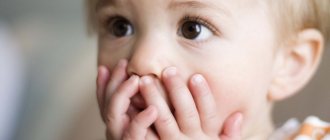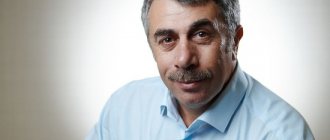When a non-speaking child comes to our center, for successful correction we must determine the cause of the lack of speech and understand the mechanism of the disorder. I say “we” because we usually look at “non-talkers” together with our speech therapist in the format of a comprehensive consultation. Each from his own side. Let's start from afar: does the child have hearing problems? What does the ENT say? In 99% of cases, the child is “hearing,” that is, hearing is defined as normal.
In order to see the speed of processing auditory impulses in the brain, there is a simple test: you can throw a thick book on the floor behind the child (one of my teachers does this). I just clap my hands loudly behind the child’s back at the most unexpected moment. Very often the child turns his head only after a few seconds (!). This is called slow orientation to sound. Remember yourself. If you suddenly hear a sharp loud sound behind your ear, your whole body will shake! Imagine how slow the processing of an auditory impulse is in a child if, firstly, the reaction is weakened (not the whole body shudders, but only turns around slightly), and secondly, not instantly, but after a while.
Next, we look at whether the child understands the spoken speech. To do this, we give various instructions, tests and observe how the child reacts, understands or does not understand, performs or does not perform. We deceive, we confuse. We give the same instructions in different versions: “show your nose, your bear’s, your mother’s, my nose!” And so on. We definitely ask parents to make a diagnosis using the ASVP (acoustic brainstem evoked potentials) and CEP (cognitive evoked potentials) methods. As a rule, sample results are confirmed by hardware examinations.
Often, when parents come to an appointment, they say that the child “understands” speech, but this is not confirmed by tests. The nuance here is that even animals “understand” human speech, but not in the way we think. For them, speech is not a set of semantic signs, but simply a kind of general noise signal to which they get used to reacting in one way or another. For example, dogs get used to the fact that after the word “walk” the owner will take the pet outside, so they run to the door. But if you say a similar-sounding word with a different meaning, they will react the same way. That is, this is the level of habit, “stimulus-response”, and not a meaningful and voluntary reaction to addressed speech. At approximately the same level, children with impaired recognition of addressed speech get used to “understanding” speech. However, any changes in the situation, wording, or change of interlocutor will cause confusion in the child.
Often such children behave like children with ASD. Imagine if you grew up in a speech vacuum. This leaves a strong imprint on the entire emotional, communicative sphere, cognitive development (in the absence of correction, secondary mental retardation develops), behavior (such children are said to be hyperactive, but their behavior problems are caused by the lack of internal speech, because speech is even internal does not develop, unlike pure motor alalia).
Impaired understanding of spoken speech may be caused by speech auditory agnosia and sensory alalia. Now it is fashionable to separate these two disorders in theory, but in practice we still rarely see pure sensory alalia without a violation of auditory speech perception.
Causes of speech regression
At different stages of development, the baby may stop making sounds, words, cooing or babbling. Various factors influence this. If a baby stops speaking at one year old, this is not always a cause for concern. The reason may lie in a change in situation. Therefore, if the child has stopped speaking, then medical intervention may not be required. Classes with a teacher and speech therapist will be enough.
There are three groups of reasons why a child may stop talking:
- Psychological. Parents often notice that the child knew a lot of words, and then stopped talking completely. This may happen due to:
- due to severe stress, such as the loss of a parent;
- children also speak and then become silent due to quarrels in the family, emotional turmoil due to accidents and other negative situations;
- after a fright. Often such a minor event as sudden braking of a car or loud noises lead to the fact that the baby stops speaking completely. In these cases, the help of a psychologist and speech therapist is required.
- strong parental pressure. Many mothers and fathers want to speed up their baby’s speech development. However, excessive loads can have the opposite effect. A developed child may become completely silent within a year after speaking absolutely normally;
- change of scenery. If the baby stops speaking when moving to a new kindergarten, then the problem lies in stress. It will be solved by a psychologist or a competent teacher.
- Physiological. Aphasia is a partial or complete breakdown of speech that has begun to form. It manifests itself when the speech parts of the brain or pathways are damaged. Your baby may talk and then stop because:
- ischemic or hemorrhagic stroke;
- traumatic brain injury;
- inflammation of the brain (encephalitis, abscess, etc.);
- diseases of the central nervous system;
- brain tumors;
- mental illness;
- brain surgery.
If the child stops speaking words for no apparent reason, then it is necessary to exclude or confirm aphasia. To select an effective correction method, the type of pathology should be determined.
How does auditory speech agnosia differ from sensory alalia?
I’ll tell you a little about the development of speech understanding in ontogenesis. At the age of up to 1 year, priority development occurs in the temporal region of the right hemisphere. That is, the child first of all matures the ability to holistically perceive non-speech (objective) noises (loudness, tonality, source, melody, rhythm, intonation). Non-speech noises also include sounds made by animals. This is the foundation for subsequent understanding of speech, which is why it is so important for children to provide a varied sound environment. As a result, the child develops his first onomatopoeias. In correction, speech therapists also use techniques to distinguish between various object noises to pass this stage of development (if it has been disrupted) and the subsequent formation of speech auditory gnosis.
At the age of about 1-1.2 years, the secondary fields of the temporal cortex of the left hemisphere are activated (they mature completely by 2 years). And in the noise stream the child begins to isolate speech sounds. His onomatopoeias acquire a “human” pronunciation, vocalizations, normative echolalia (repetitions of heard words), and interjections (oh, bang, bam) begin. This is not one sound, but a series of sounds and simple words that can already be used in a familiar context (mom, dad, baba). This is the stage of maturation of speech auditory gnosis. The child does not yet have the ability to understand the polysemy of words; context (necessarily substantive) is important. Immaturity of the secondary fields of the temporal cortex results in speech auditory agnosia . And if this stage has not been passed, then further development of speech understanding does not occur.
Next, the tertiary fields of the cortex mature - this is the zone where the “overlap” of the parietal, temporal and occipital cortices occurs. The so-called TPO zone. Or the posterior association cortex. And the words perceived by the secondary cortex begin to be saturated with different meanings, connected with each other, acquiring semantic shades and developing without a strict connection to one object. The child begins to master his native language. Among biological species, only humans have tertiary fields. Violation at this stage leads to sensory alalia.
The main practical problem is that the immaturity of the previous level of the auditory analyzer leads to underdevelopment of the next one. Sometimes it is impossible to clearly differentiate whether the formation of only secondary or tertiary fields at the stage is disrupted. And as hardware diagnostics using the evoked potential method shows, impulse conduction is often disrupted in children, not reaching the cortex at all! That is, in essence, they have mild sensorineural hearing loss, which was not identified in a timely manner. And if the impulse to the cortex comes with a delay and in incomplete volume, then the primary, secondary, and tertiary cortex suffer. Language acquisition and thinking are impaired.
Types of aphasia
- Amnestic aphasia. The child forgets or confuses different words. At the same time, he can describe the object. For example, children do not say “car”, but “you can drive this”. If you remind a child of a word, he will say it, but then forget it again.
- Motor aphasia. A child who is one year old or older can understand speech perfectly. But at the same time, depending on the stage, he answers indistinctly or is simply silent.
- Sensory aphasia. The child has difficulty understanding speech. He does not respond to the requests of others. Such children do not stop talking, but begin to utter different phrases meaninglessly.
- Total aphasia. Children say nothing and do not understand speech. This is the most serious form of pathology.
Normal development of children's speech at one and a half years
By the beginning of the second half of the year, children can have from 30 to 50 words in their vocabulary. They use them both of their own free will and as answers to questions from others.
The passive vocabulary by this time has a much larger number of words and concepts. In the next six months, that is, from one and a half to two years, the child gradually transfers words from a passive vocabulary to an active one. This process is growing like an avalanche. Experts call it a “lexical explosion.”
Almost every day children learn new and new words. At the age of one and a half years, many children who have developed speech in accordance with age standards combine two words into one sentence. “Give me a doll” (give me a doll, a cube), “Papa is not there” (dad is not at home), “Baba give me” - here are a few similar sentences from root words. Sometimes children as young as one and a half years use only one-syllable sentences: “Boom,” “Yum-yum,” “Beep.”
If the child’s speech development does not correspond to the average statistical norm (at 1.5 years the baby does not say not only 1-2 word sentences, but also does not say the required number of words, or does not say anything at all), then parents should start stimulating the child’s speech.
Correction of speech regression
If the baby has stopped babbling or speaking, then you need to immediately figure out the cause of the illness. First of all, you should visit an appropriate specialist. If the baby suddenly stops talking due to stress, then an examination by a psychologist will be required. If there are no apparent reasons, you should visit a neurologist. A child who has stopped speaking due to aphasia first needs treatment for the underlying disease.
The child may be prescribed:
- medications;
- surgery;
- mechanotherapy and physiotherapy;
- speech therapy massage and exercise therapy.
For children who do not speak, speech therapy sessions are also prescribed. Teachers help the child restore speech. Writing and reading skills are developed (if necessary). If the child has stopped speaking, then correctional classes with a neuropsychologist and/or speech therapist should begin as early as possible. This can be done at the NEAPL Center for Speech Therapy and Psychology. Experienced specialists will identify the cause of speech regression and, if necessary, refer you to specialized doctors or select an effective corrective program.
When should you worry?
Each child has a “convenient” pace of development. One began to babble earlier, the other was the first to sit down or stand up, and the third walked and spoke before his comrades in the sandbox. If age-related variations occur within a couple of months, there is no need to worry.
However, all parents need to know the norms of children’s speech development. If the lag becomes significant (and speech therapists consider a delay of no more than 2-3 months to be a normal option for a particular skill), it is better to seek advice from a specialist.
Children usually begin to say the notorious word “mother” by the age of one or one and a half years. What if the first birthday has been celebrated a long time ago, but the long-awaited word is still missing? Is it time to go to the doctors?
Consulting a specialist never hurts. When it comes to speech development, you shouldn’t wait for everything to form “somehow on its own.” However, in order not to panic ahead of time, take a closer look at your baby. It is quite possible that he is simply a little delayed in pronouncing the words so expected by his parents and nothing terrible happens. Important factors:
- A one-year-old child understands speech addressed to him. That is, it responds to its own name and gives an adequate reaction to the words of its parents.
- There are no hearing or vision impairments.
- The baby's cooing was replaced by babbling speech. The child is already trying to designate specific words with some kind of imitative syllables.
- In games, there is a noticeable desire to repeat after an adult and perform given actions.
At an early age, the process of speech formation is closely related to the development of the psyche and thinking. Parents should keep an eye on these aspects. If any suspicions still arise, it is best to seek advice from specialists.
Who to visit:
- neurologist;
- child psychologist;
- speech therapist-defectologist.
Prognosis and prevention
If your baby was talking and then suddenly fell silent, then don’t despair. In most cases, the prognosis is very favorable. Timely correction allows you to eradicate the pathology. The exception is cases when the baby has stopped speaking words due to severe damage to the central nervous system or Landau-Kleffner syndrome.
To prevent a child from becoming silent, parents must pay special attention to his emotional state. At the first signs of stress, it is better to contact a psychologist. The child should be surrounded with care and helped to develop his speech. However, no preventive measures have been created to prevent aphasia. The only thing parents can do for their child is to undergo timely medical examinations, prevent traumatic brain injuries and severe neuroinfections.
Treatment and correction of speech delay
The Bersenev Medical Center provides comprehensive treatment for delayed psycho-speech development in children. The clinic’s specialists draw up an individual program for the treatment and correction of mental retardation for each individual child. The program includes a set of rehabilitation activities carried out by a pediatric neurologist, massage therapist and speech therapist. A psychologist, a reflexologist and, of course, parents also take part in the treatment.
One of the main tasks of parents is to eliminate the causes that caused the delay in psycho-speech development (this applies to families with an unfavorable environment). Very important points in treatment are attentiveness to the child, moral support and patience, because correction of PVD is a complex and painstaking process.
If you detect the problem in a timely manner and contact a specialist, complete all the appointments and have a good attitude, you are guaranteed to have good results, high effectiveness of treatment, and the fact that ZPRD will not affect your child’s future in any way.
Year three
The development of the child’s cognitive sphere “provokes” intensive development of speech. He is already repeating more complex words and even phrases, his vocabulary is actively expanding (by the age of 3 it is about 1000-1200 words). The baby is already making sentences from words, coordinating grammatical forms. The development of the phonetic system of the language also continues: the child learns to pronounce the sounds [s'], [z'], [ts'], [l']. However, the articulatory apparatus is not yet sufficiently developed, so the pronunciation of these sounds is not at all ideal. “Difficult” for the child are also hissing [w], [zh], [ch'], [sh'], which he can replace with soft or hard whistling ones (instead of “hat” he pronounces “syapka” or “sapka”, instead of “ beetle" - "zyuk"). The sounds [r], [r'] and [l'] are also absent in speech (sometimes children replace them with [l'] or [th]: “ul” (steering wheel), “dvel” (door), “may "(chalk). But the labial, middle and back lingual consonants ([p], [p'], [b], [b'], [m], [m'], [f], [f'] , [v], [v'], [k], [k'], [g], [g'], [x], [x'], [t], [t'], [d], [d'], [n], [n']) should already be correct.
If by the age of three your child does not speak or speaks very little , this is already a reason to worry and determine the reason for such a delay. The delay can be due to both physiological reasons (diseases of the ENT organs, physical exhaustion caused by serious illnesses, damage to the central nervous system accompanied by mental retardation) and psychological reasons (lack of communication and attention from adults). In any case, you should contact specialists as soon as possible. After all, the longer the period of developmental lag, the more difficult it is to catch up.








